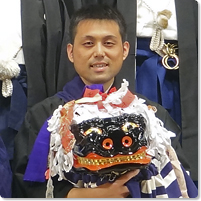Hiroki Tanaka

© Yuichiro Kariya
Hiroki Tanaka
Kuromori Kagura performer
Two years have passed since the devastating Great East Japan Earthquake and Tsunami of March 11, 2011. The northeastern Tohoku region that experienced such unprecedented devastation is also a region that has long been known for its rich store of folk arts. Notable among them are the folk arts of Iwate Prefecture, some of which date back a thousand years. One of these is Kuromori Kagura, a tradition of ritual dance and music based in the Kuromori Shrine of the city of Miyako and performed by troupes of performers who travel from village to village over a wide area of the Sanriku coast from Kuji in the north to Ishinomaki in the south a form of spiritual pilgrimage. In 2006, this precious tradition was officially recognized by the national government as an Important Intangible Folk Cultural Asset. However, the March 2011 disaster also dealt a blow that has threatened the future of this serious 400-year-old tradition, and many of the local inns that long welcomed the kagura performers with lodging on their pilgrimage routes were damaged by the tsunami. But, the kagura performers are continuing to tour and perform in order to bring inspiration and courage to the people of the stricken areas. Also, with support from the Japan Foundation and Agency for Cultural Affairs, Kuromori Kagura performers have traveled to Russia, France and the U.S. to perform and show the spirit of Japan’s traditional folk arts and their determination to overcome hardship while giving performances in appreciation of the aid that poured into Japan from people in countries worldwide after the disaster. The folk arts are a pillar of the region that links the people of its communities, and for that reason their revival is vital for the region’s recovery.

